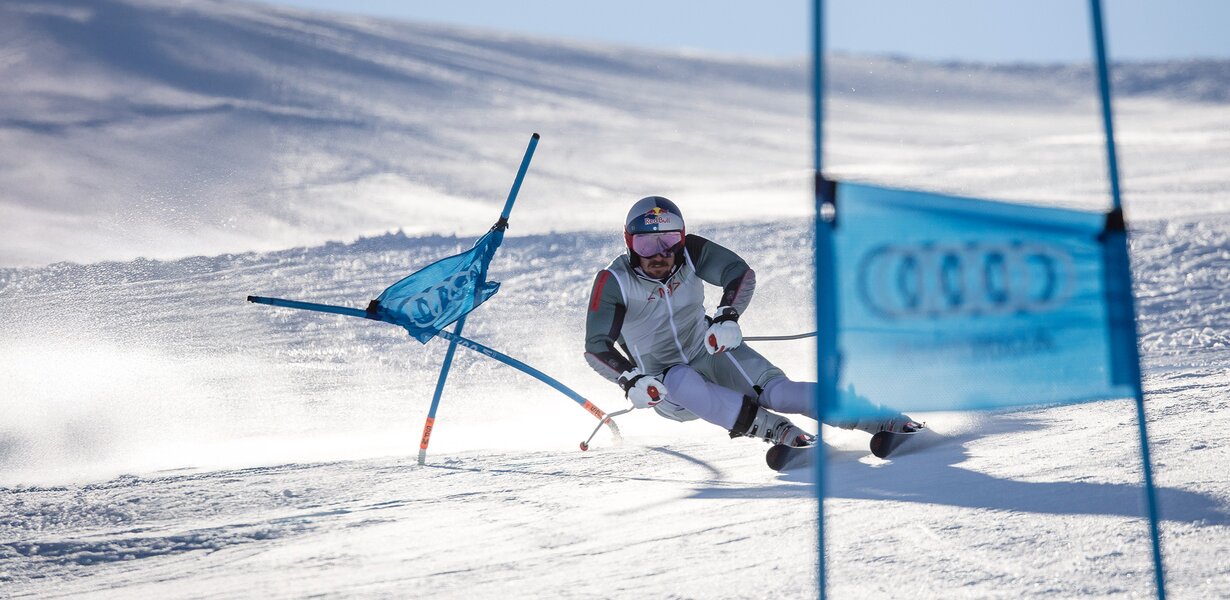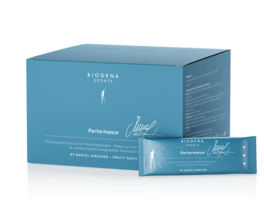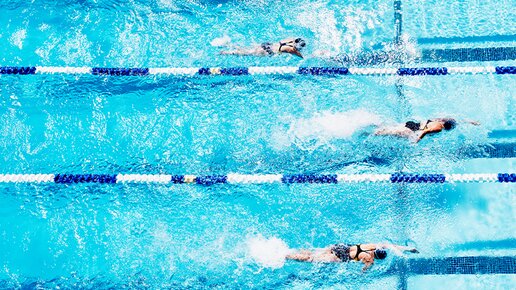Endurance sports melt our kilos, keep us fit, free up our heads and have become a passion for many. It is particularly fun when the sweaty training sessions bear fruit and your endurance improves. Learn more about effective tools and tips to help increase your endurance.
Physical endurance – a brief introduction
Endurance describes the ability to maintain a stress level without fatigue for as long as possible. People who have good endurance, for example, can run, swim or cycle for a long time.
In German, the terms endurance and condition are often equated with one another. In fact, however, the condition includes far more than just stamina, but describes our general sporting performance, which is also influenced by strength, speed, mobility and coordination in addition to stamina.
Endurance sports for beginners
Many people associate cycling, jogging or even running a marathon with endurance sports. But the possibilities of training for endurance are far greater! No-one has to do an hourly run if they prefer mountain hikes or dancing.
Sports that are particularly suitable for beginners include:
- Easy hikes
- Slow jogging
- Nordic walking
- Dancing
- Swimming
- Cycling (also using an ergometer)
It’s hard to get started. However, after just a short time you will feel that training endurance has a positive effect on your whole body.
How quickly can your endurance be improved?
Perseverance and patience are needed to increase endurance. Above all, absolute beginners who follow a simple but regular training plan can feel a significant improvement after just 4-6 weeks.
More profound successes, such as a lower pulse at the same walking speed, take more time to achieve (~ 3 to 6 months). Finally, recurring stimuli are necessary so that our entire organism, including the cardiovascular system, can adapt.
How can you improve your endurance?
To improve endurance, training should be carried out at least two to three times a week for at least 20 to 30 minutes. Beginners in particular can use a pulse watch to optimise their training successes. After all, it is important to recognise your individual stress limit and not to go beyond it.
The so-called stress pulse helps to control the intensity of the training. The stress pulse is the heart rate that is measured during physical exertion. The heart rate in turn indicates the number of heartbeats per minute. In order to be meaningful, the heart rate should be measured no later than 10 seconds after the end of the exercise.
How high the pulse should be when walking, cycling, etc. depends on age. Thus, the recommended maximum pulse decreases with increasing age. The formula for calculating the upper stress limit is “220” minus age.
| Age | 20 | 30 | 40 | 50 | 60 | 70 |
|
Maximum pulse |
220 |
190 |
180 |
170 |
160 |
150 |
|
Warning area |
200-220 |
175–190 |
165–180 |
155–170 |
145–160 |
135–150 |
|
Anaerobic area |
175–200 |
155–175 |
145–165 |
135–155 |
130–145 |
120–135 |
|
Aerobeic area |
155–175 |
135–155 |
125–145 |
120–135 |
115–130 |
105–120 |
|
Fat burning area |
130–155 |
115–135 |
110–125 |
105–120 |
95–115 |
90–105 |
|
Health area |
110–130 |
95–115 |
90–100 |
85–105 |
80–95 |
75–90 |
Table: Reference values for pulse rate with endurance training. (Source: adapted from DKV)
Those who regularly train in the aerobic area improve their aerobic performance and basic endurance. At this frequency range, our cells have sufficient oxygen available for energy production. The body learns to source its energy primarily from fats, thereby protecting carbohydrate stores.
People who do not have a heart rate monitor can also train in the aerobic area using a simple trick. They should train at such an intensity that they are sweating, but still have enough breath to be able to have a good conversation.
What is basic endurance?
People who have good basic endurance are generally able to perform for longer. Good basic endurance helps to improve performance in almost all sports and also makes everyday life a lot easier.
What sports can you use to increase your endurance?
Whether at home, in the gym or in the great outdoors: Endurance sports should be fun and at the same time physically demanding. Those who have not yet found anything appealing among classic endurance sports can also try out new sports to possibly discover a new passion.
Endurance sports include, for example:
- Nordic walking
- Jogging
- Hiking
- Mountain climbing
- Cycling/racing
- Ergometer training
- Crossfit
- Triathlon
- Cross-country skiing
- Skiing
- Dancing
- Rowing
- Canoeing
- Fast ice skating
- Inline skating
- Badminton
- (Table) tennis
- Jumping Fitness (trampolining)
- Pound (cardio workout with drumsticks)
Increase endurance effectively with these tools & tips
1. Increased endurance with the right diet
A healthy, balanced diet provides endurance athletes with energy (= macronutrients) and the necessary materials (= micronutrients) they need to perform.
Carbohydrates continue to play the main role in endurance sports, according to current reviews (= study summaries). Carbohydrate intake prior to exercise has been shown to have a positive effect on performance during prolonged exercise, but not for shorter bouts, according to studies. While the intake of easily digestible carbohydrates (e.g. sweet potato, rice cakes) is recommended before training, complex carbohydrates should be used in everyday life. The ideal energy providers are whole, unprocessed foods such as potatoes, whole grain rice or whole grain bread.
The role of protein is less well-known in endurance sports, but it should not be underestimated. Adequate daily protein intake and immediate protein intake after training have a positive effect on regeneration, the reduction of muscle damage and the maintenance of muscle mass.
Thanks to scientific studies, fats have recently gained popularity among ultra-endurance athletes. However, endurance athletes who train at a “normal level” are generally not expected to improve their performance through a high-fat diet.
2. These micro-nutrients & supplements support endurance
The right micronutrient package takes endurance to the next level. Sophisticated performance supplements can perfectly accompany endurance athletes in all their training and competition phases and improve their performance. Ultimately, endurance training challenges the entire metabolism and also requires a variety of different micronutrients – micronutrients that can be specifically supplied in the form of supplements.
- Micronutrients support energy production: To have staying power in endurance sports, faultless energy metabolism is key. Numerous micronutrients play their part in energy production. Perhaps the most resonant name among them is coenzyme Q10 (ubiquinol), an important player in the respiratory chain – this is what we call the energy generation process in our cellular power plants, called the mitochondria, which ultimately produce ATP (= the body’s fuel). However, other micronutrients, such as vitamin B2, iron, copper and zinc, also contribute to the respiratory chain. Only if these “cofactors” are available in sufficient quantities does the energy utilisation run “like clockwork”. In contrast, L-carnitine, which sends the fatty acids into the mitochondria like a "shuttle", where they are then subsequently used to generate energy, is used a little earlier in energy metabolism.
- Micronutrients increase speed: Creatine is a compound found in the body, mainly in the muscles. Here it contributes to the energy supply in the form of creatine phosphate. Studies show that a daily intake of 3 g creatine significantly increases physical performance during rapid strength training in short, intensive bouts.
- Micronutrients promote optimal muscle performance: Healthy muscle activity forms the basis for any sporting performance. While the minerals potassium, calcium and magnesium ensure a smooth muscle function, the branched chain amino acids (BCAA) L-leucine, L-valine and L-isoleucine support the growth and recovery of our muscles.
- Micronutrients – essential for blood and oxygen transport: So that we don’t run out of energy and breath during endurance training, the smooth transport of oxygen is indispensable. Iron is an important component of red blood cells. As such, it contributes to oxygen transport throughout the body, which is crucial for improving endurance. Vitamin B12 contributes to the formation of red blood cells and enhances this effect.
- Micronutrients can withstand oxidative stress: Intensive physical activity is associated with increased free radical formation. In order to prevent oxidative stress, antioxidants such as selenium and vitamin E protect cells from aggressive particles after intense training.
- Micronutrients contribute to the electrolyte balance: Training endurance can cause you to work up a sweat sooner or later. Not only fluid, but also electrolytes, such as potassium and sodium, are lost, which should be replaced. In order to avoid convulsions and muscle fatigue, especially during long-term training, magnesium deficiency (which is excreted in intensified form via the kidneys) must be avoided.
- Micronutrients sharpen the focus: In endurance sports, mental strength is needed in addition to physical strength. Mental strength can be trained through relaxation techniques, but can also be promoted with the right micronutrients. Pantothenic acid, also known as vitamin B5, supports mental performance and provides other vitamins, such as Vitamin B6, biotin and niacin for a clear focus, no matter how intense the training.
- Plant substances increase resistance: Not only micronutrients, but also plant extracts that have been carefully selected can be useful for endurance sports. Ashwagandha is one of these. This adaptogen is particularly known for its stress-reducing properties. In sport, Ashwagandha helps to promote regeneration and increase muscle strength. In addition, it improves mental resilience, which is particularly beneficial in intensive training and competition phases.
So countless micronutrients contribute to sporting peak performance. Only the fewest supplements approximately cover the diverse needs of athletes.
3. Beginners: Build endurance step by step
A structured training plan is the ideal tool for improving endurance. This helps you stay on the ball, free up your time for the training sessions and record their intensity and duration. The key to increasing your endurance is to gradually increase the training burden. Beginners should start with short training sessions and gradually increase the duration and intensity. After all, the organism has to get used to the new stress first – and it takes time for that.
4. Advanced: Increase endurance with HIIT
Athletes who already have a little more experience in endurance training and want to increase their fitness more quickly can resort to more advanced training methods. One of THE fitness trends of recent years is the so-called “high-intensity interval training” (HIIT). In this, short periods of stress usually vary from 20 – 60 seconds with short active recovery phases from about 10 – 30 seconds. As training equipment, rowing machines, treadmills, bicycle ergometers or cross trainers are primarily used. While experienced endurance athletes usually train for 45 – 90 minutes, a HIIT unit plus warm up time takes between 10 – 20 minutes. Another HIIT characteristic is that the stress phases are in the upper anaerobic range, which causes lactic acid (lactate) to accumulate in muscles and blood. In the recovery phases or after training, this is slowly reduced again.
Compared to traditional endurance and aerobic interval training, HIIT has the following advantages:
- A faster increase in endurance
- A training boost and incentive for ambitious amateur and competitive athletes
- An improvement in lactate tolerance
- Better fat burning
- A shorter training time
5. Treat yourself to breaks and promote regeneration
Regardless of whether you are already in top form or are still at the very beginning of your “endurance career”, the importance of sufficient breaks and regeneration phases should not be underestimated. After all, our bodies need these to make progress and avoid injuries. In addition, the break can also be used to reflect and adapt the training plan to the new progress made.
6. Sufficient sleep
Sufficient sleep is one of the best recipes for rejuvenation. During this time-out, the body can repair itself, the muscles relax, the heart rate and blood pressure decrease and detoxification can be in full swing. In the course of sport, there are small inflammatory processes that are remedied by the body's own self-healing properties during sleep. Therefore, sports enthusiasts also have a higher need for sleep compared to couch potatoes.
Healthy and powerful with endurance training
Endurance training is an investment in your health. At the end of the day, endurance training on several levels is worthwhile:
Improved endurance to support heart rate and pulse
- The resting pulse is lower
- Blood pressure drops
- Cardiac output increases
- The heart muscle is strengthened and better supplied with blood
- The oxygen requirement decreases for certain types of cardiac performance
Endurance training is good for blood circulation and the vessels
- The number of red blood cells increases
- Maximum oxygen uptake increases
- New capillaries are formed in and around the heart
- Blood flow improves
- The risk of thrombosis is reduced
Increased stamina strengthens the lungs
- The blood flow is increased
- Our breathing becomes stronger and more efficient
- The air supply is improved
Improved endurance strengthens muscles
- Muscles become firmer
- Muscle activity becomes more efficient
- Muscle blood flow is increased
- New capillaries are formed in the muscle
- Muscle metabolism improves
- The number of mitochondria (= cellular power plants) increases
Endurance sports are good for the mind, the body and stress resistance
- The blood flow to the brain is improved
- The linking of brain cells is improved
- The ability to concentrate increases
- The happiness hormone serotonin is formed more frequently
- The stress hormones decrease
- The parasympathetic nervous system is activated
- Stress tolerance is improved
Moderate endurance training strengthens defences
- The immune cells multiply
- The immune cells become more active
The open window effect: When intensive training weakens the immune system
Sport strengthens your defences. However, if we overdo it, we will experience the opposite for a while. For example, after exhaustive training, the “window” for pathogens is open for a period of approx. 3 to 72 hours – we become ill more easily. This is called the "open window effect".
Conclusion: Those who practice endurance pay into their body’s health insurance. The good news for newcomers is that it’s never too late to start endurance sports. In order for endurance training to bear fruit as quickly as possible, it should also be accompanied by a healthy diet and lifestyle as well as a performance supplement.
FAQs on the topic of increasing endurance
Beginners can quickly improve their endurance by following a simple training schedule and working out regularly. Noticeable progress is often seen as early as 4-6 weeks. Skilled endurance athletes can improve their endurance more quickly through special training sessions such as HIIT.
Improving endurance in 2 weeks is an unrealistic goal. Endurance should be continuously increased over a longer period of time.
In order to improve endurance, training should be performed several times a week in the aerobic area. More advanced athletes can also resort to special training courses (e.g. HIIT). In addition, a healthy diet and lifestyle, as well as a tailored supplement, can help to increase endurance.
Further references:
Vitale K, Getzin A. 2019. Nutrition and Supplement Update for the Endurance Athlete: Review and Recommendations. Nutrients 2019, 11(6), 1289.
Rothschild J, et al. 2020- What Shout I Eat before Exercise? Pre-Exercise Nutrition and the Response to Endurance Exercise: Current Prospective and Future Directions. Nutrients. 2020 Nov 12;12(11):3473.
Santos de Sousa Fernandes M. et al. 2023. Coenzyme Q10 Supplementation in Athletes: A Systematic Review. Nutrients. 2023 Sep 15;15(18):3990. doi: 10.3390/nu15183990.
Bonilla D.A. 2021. Effects of Ashwagandha (Withania somnifera) on Physical Performance: Systematic Review and Bayesian Meta-Analysis. J Funct Morphol Kinesiol. 2021 Feb 11;6(1):20. doi: 10.3390/jfmk6010020.
Greer B.K. 2007. Branched-chain amino acid supplementation and indicators of muscle damage after endurance exercise. Int J Sport Nutr Exerc Metab. 17(6):595-607.
Negro M. et al. 2008. Branch-chain amino acid supplementation does not enhance athletic performance but affects muscle recovery and the immune system. J Sports Med Phys Fitness. 48(3):347-51.
Hanna M. et al. 2022. B Vitamins: Functions and Uses in Medicine. Perm J. 2022 Jun 29;26(2):89-97. doi: 10.7812/TPP/21.204. Epub 2022 Jun 17.
Schmidbauer C et al. 2024. Mikronährstoff-Coach – Das große BIOGENA-Kompendium der Nährstoffe. https://www.mikronaehrstoffcoach.com/de/at/index.html
Further literature from the author.










